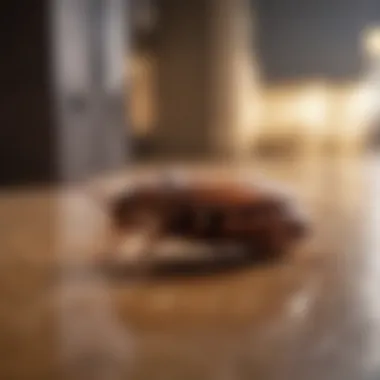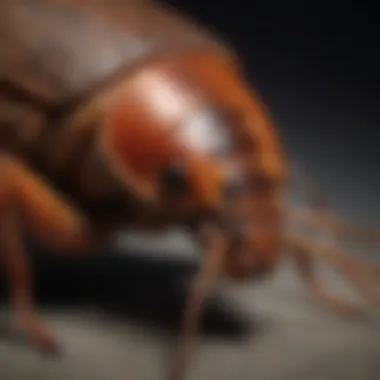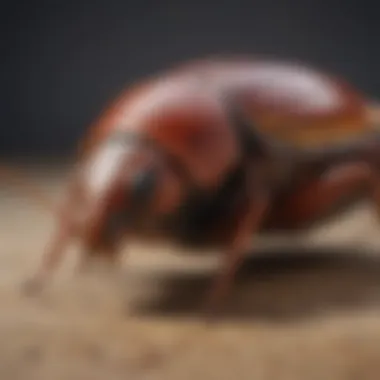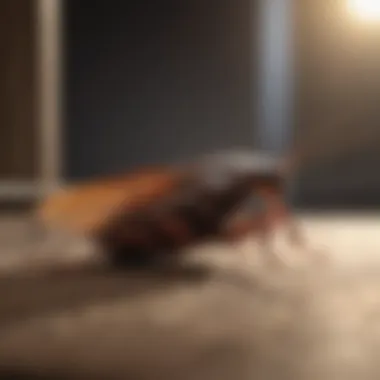Understanding German Cockroaches: Flight and Control


Intro
German cockroaches, Blattella germanica, are notorious household pests that often invoke fear and disgust. They are small, light brown insects and can quickly become a significant problem in residential areas. Often misunderstood, these cockroaches are commonly perceived as flying insects. This article aims to shed light on their true capabilities, debunk myths surrounding their flight, and provide practical advice for homeowners.
Understanding the biology and behavior of German cockroaches is essential for effective pest management. Knowledge of their characteristics will enable homeowners to identify them, recognize signs of infestation, and apply appropriate treatment strategies. This comprehensive guide serves as a resource for anyone looking to maintain a cleaner, pest-free home.
Pest Identification
Proper pest identification is the first step in effective pest control. The German cockroach can be distinguished from other pests through specific characteristics and behaviors.
Detailed descriptions of common pests
German cockroaches are relatively small, measuring about 1.1 to 1.6 cm in length. They have a flattened body and long antennae. Their wings are present, but their flight capabilities are limited. Instead, they prefer to run. Here are key features for identification:
- Color: Light brown to tan with two dark stripes on the pronotum (the shield-like structure behind the head).
- Body shape: Flattened, oval body, allowing them to hide in small spaces.
- Antennae: Long and thin, can reach the length of their body.
In contrast, other common household pests like the American cockroach or the Oriental cockroach exhibit more significant size differences and color variations. The appearance of these insects can often lead to confusion in identification, highlighting the importance of knowing the German cockroach's unique traits.
Signs and symptoms of infestations
Recognizing a German cockroach infestation early can help prevent widespread problems. Homeowners should watch for these signs:
- Droppings: Small, dark fecal pellets, about the size of a peppercorn.
- Egg cases: Brown, capsule-like cases known as oothecae, containing up to 40 eggs, can often be found in hidden areas.
- Unpleasant odor: An accumulation of cockroaches can lead to a noticeable, musty scent.
Important: It's crucial to act quickly if you observe these signs. Delaying action can lead to a larger infestation, making it more challenging and costly to manage.
Prevention Strategies
Preventing German cockroaches in your home requires diligence and proper maintenance.
Home maintenance tips for pest prevention
Several proactive measures can significantly reduce the likelihood of cockroach infestations:
- Seal entry points: Use caulk to seal cracks around windows, doors, and pipes where cockroaches might enter.
- Keep clean: Regularly clean surfaces, especially in kitchens and dining areas. Crumbs and spills attract these pests.
- Manage moisture: Fix leaks and reduce humidity within the home, as German cockroaches thrive in damp environments.
Natural deterrents and barriers
Incorporating natural strategies can also help deter cockroaches. Consider:
- Essential oils: Some oils, like peppermint or tea tree oil, can repel cockroaches.
- Diatomaceous earth: Sprinkling this powder in areas where cockroaches frequent can help due to its desiccating properties.
Treatment Options
When prevention fails, treatment becomes necessary. Homeowners have various options available.
Overview of chemical vs. natural treatments
Chemical treatments often include insecticides that target cockroach behavior. However, natural treatments can be effective and safer for households with children or pets. Each has its place, depending on the severity of the infestation and personal preferences.
Step-by-step guides for DIY treatments
For those opting for natural methods, here’s a simple DIY approach:
- Set bait stations: Mix boric acid with sugar and water. Place this mixture in bait stations around the home.
- Create traps: Use a jar with a piece of bread as bait. Coat the interior with petroleum jelly to trap cockroaches that enter.
Being knowledgeable about your pest situation is vital.


Effective pest management begins with understanding the pest you are dealing with. Proper identification, prevention, and treatment strategies are key to maintaining a cockroach-free environment.
In summary, deeper insights into German cockroaches will prepare homeowners for recognizing and addressing infestations effectively.
Several reliable resources are available for further information:
By staying informed and proactive, homeowners can significantly decrease their risk of infestations.
Prelude to German Cockroaches
Understanding German cockroaches is a critical aspect for homeowners as they are one of the most common household pests. Their presence can lead to various health risks and create discomfort in living environments. Therefore, learning about their habits, flight capabilities, and biological characteristics becomes essential for effective pest management.
The German cockroach, scientifically known as Blattella germanica, possesses unique traits that make infestations particularly challenging. Not only do they reproduce rapidly, but they also adapt well to human environments. For homeowners, this means that early detection and effective prevention methods can mitigate the problems caused by these insects.
Knowledge about the taxonomy, origin, and physical characteristics of German cockroaches helps in identifying them accurately. It is also crucial to understand how their flight abilities, or lack thereof, influence their behavior and spread within a residence. This article aims to provide insights that can equip readers with actionable strategies for managing these pests.
German Cockroaches and Their Flight Abilities
Understanding the flight capabilities of German cockroaches is essential for effective pest control and prevention. Many people believe these insects can fly, while others think they are entirely ground-dwelling. This section aims to clarify these concepts, as well as their implications on household infestations. Knowing how, when, and why these insects may take to the air can influence how homeowners approach pest management strategies. This knowledge can assist in devising effective preventive measures or treatments when necessary.
Do German Cockroaches Fly?
German cockroaches, scientifically known as Blattella germanica, are often mistaken as proficient flyers. In reality, while they possess wings, they do not typically use them for flight. Instead, their ability to glide for short distances can seem like flying. The wings serve more as a protective covering for their bodies and are primarily important during mating displays or as a means of escaping predators. It is not unusual for people to witness a roach drop from a ledge or glide downwards. However, this is often a result of them being startled or disturbed.
Analyzing Wing Structure
The wing structure of German cockroaches gives insight into their flight capabilities. They have two pairs of wings, which are slender and membranous. While these wings can create a surface area for gliding, their slenderness limits their effectiveness in propelling the bug into the air. The forewings are somewhat hardened, providing protection to the delicate hindwings. This structure illustrates that even though they can glide, proper flight is not one of their primary adaptations. This limitation is essential to note for pest management professionals focusing on strategies against infestations.
Factors Influencing Flight
The factors influencing the flying behavior of German cockroaches are varied and include several key individuals or environmental elements.
Age
Age is a significant factor that affects the flight capability of German cockroaches. Younger cockroaches tend to be more agile and adept at gliding. In contrast, older roaches exhibit slower movements and may rely primarily on their legs for navigation. This change in capability can inform pest control strategies; for instance, targeting younger populations may be more effective as they can glide easier.
Environmental Conditions
Environmental conditions play a crucial role in a cockroach's ability to utilize its wings. Temperature, humidity, and light exposure can affect their behavior. For instance, German cockroaches prefer warm environments, and higher temperatures can lead to increased activity and attempts to glide. Darker conditions may prompt them to use their gliding ability as an escape mechanism. Understanding these influences helps homeowners create less inviting habitats for these pests.
Stress Factors
Stress factors greatly impact the flying behavior of German cockroaches. When threatened, they may instinctively attempt to fly or glide away from danger. This reaction to stress is common among many insects and provides insight into their survival instincts. By recognizing stress triggers, homeowners can better manage their environments to minimize potential attractants that could lead to infestations.
Prevalent Myths and Misconceptions
The topic of prevalent myths and misconceptions surrounding German cockroaches is critical in understanding how these pests are perceived and managed. Often, these myths can lead to unnecessary fear and ineffective management strategies. Addressing these misconceptions allows homeowners to make informed decisions regarding pest control.
Common Myths Addressed
One pervasive myth is that German cockroaches are capable of sustained flight. In truth, while they possess wings, they rarely utilize them for flying. Instead, these insects prefer to scurry on surfaces, which is more efficient for their survival. Due to their rapid movement, it may appear they can fly, especially if startled.
Another myth is that the presence of German cockroaches indicates poor hygiene. While cleanliness can reduce infestations, cockroaches can thrive in various environments, including clean homes. They seek shelter, food, and moisture, leading them to invade areas often regarded as tidy. This misconception can lead to a stigma that pressures homeowners unnecessarily.
Some believe that once German cockroaches are eliminated, they will not return. However, without preventative measures, the likelihood of reinfestation remains high. Their reproductive capabilities are significant, and even a few surviving individuals can repopulate quickly. Understanding these common myths is vital for effective management.
Implications of Misunderstandings


Misunderstandings about German cockroaches can have several implications. For instance, believing that these pests can fly might lead to panic reactions when spotting one, prompting homeowners to pursue ineffective or overly aggressive extermination strategies. This approach not only risks harming the environment but can also be costly without addressing the root causes of the infestation.
Additionally, the misconception surrounding hygiene can create false assumptions about personal cleanliness and lead to unnecessary shame or guilt among homeowners. This stigma could deter individuals from seeking help for pest control, prolonging the infestation. Proper education about these insects encourages residents to take proactive steps, focusing on effective management instead of shame or fear.
As a result, recognizing and dispelling myths about German cockroaches is essential. It promotes informed choices, positive attitudes toward pest management, and ultimately more sustainable practices. There is a critical need for public awareness to combat these misunderstandings and facilitate healthier living environments.
Habitat and Behavior of German Cockroaches
Understanding the habitat and behavior of German cockroaches is vital for effective pest control. These insects thrive in specific environments, which can determine their presence in residential settings. Knowing where German cockroaches prefer to live can help homeowners reduce infestations and minimize the risk of health issues. This section delves into two critical aspects: their preferred living environments and their feeding and reproduction habits.
Preferred Living Environments
German cockroaches prefer warm, humid environments close to food and water sources. They often inhabit kitchen and bathroom areas due to the abundance of these resources. Here are key locations where they are commonly found:
- Cracks and Crevices: They hide during the day in small cracks and crevices, which provides them protection from light and predators.
- Behind Appliances: Areas behind refrigerators, ovens, and dishwashers are common hiding spots, as these are warm and often have food residue.
- Pantries and Cabinets: German cockroaches are attracted to food stores, making pantries, cabinets, and shelves ideal for their presence.
The conditions in these environments also determine their activity levels. Warmth and moisture significantly increase their reproduction rate and lifespan. Controlling factors like humidity can help manage their population.
Feeding and Reproduction
German cockroaches are omnivorous and have a wide diet. They are not picky eaters and can consume various organic materials. Common food sources include:
- Food Residues: Leftover crumbs and spills in the kitchen and dining areas are attractive to them.
- Paper Products: They can also feed on paper, glue, and even soap products, showcasing their adaptability.
- Organic Waste: They frequent areas with organic waste, which can be found in garbage bins and compost areas.
Regarding reproduction, female German cockroaches carry their egg cases, known as oothecae, for several weeks until they are ready to hatch. Each egg case can contain up to 40 eggs. This high reproductive rate contributes to the difficulties in controlling their populations.
The female German cockroach can produce several egg cases throughout her life, resulting in significant population growth in a short time.
Health Risks Associated with German Cockroaches
German cockroaches are more than just an annoying pest. They pose significant health risks that merit attention, especially for households. Understanding these risks is crucial for housewives and homeowners alike to maintain a healthy living environment.
Cockroaches can trigger various health issues, and knowing how they affect indoor spaces can lead to better management and control strategies.
Allergens and Diseases
German cockroaches carry allergens that affect many individuals. Their droppings, saliva, and decomposing body parts can become airborne, leading to respiratory problems when inhaled. Some common allergens are linked to asthma, particularly in children and individuals with pre-existing conditions.
Research indicates that exposure to these allergens can enhance asthma severity. Moreover, German cockroaches can transmit pathogens that lead to diseases such as gastroenteritis. When these bugs come into contact with food, bacteria may transfer, resulting in foodborne illnesses.
"The presence of German cockroaches increases the risk of allergic reactions and transmissible diseases, highlighting the importance of effective pest control measures."
Impact on Indoor Air Quality
The impact of German cockroaches on indoor air quality is another essential aspect. Their waste and body parts contribute to poor air quality, particularly in enclosed spaces. Poor indoor air quality can lead to various health problems such as headaches, fatigue, and more severe respiratory issues.
Consider these key points regarding indoor air quality:
- Increased allergens can lead to health complications.
- A rise in bacteria and pathogens affects overall hygiene.
- The combined effects contribute to a harmful living environment.
To maintain optimal air quality, regular cleaning habits along with proper management of cockroach infestations are strongly encouraged. Improving ventilation and reducing humidity in homes can also minimize their infestations efficiently.
Effective Management Strategies
Effective management strategies are crucial when dealing with German cockroaches. Understanding their habits, biological characteristics, and tendencies allows homeowners and pest control professionals to create a targeted approach. This ensures not just immediate results but long-term pest prevention. The primary focus here is to reduce the chances of infestation and mitigate potential health issues these pests may cause.
Preventative Measures
Preventative measures are the first line of defense against German cockroaches. These actions can significantly reduce the risk of an infestation and contribute to an overall healthy living environment.
Sanitation Practices


Sanitation practices play a vital role in pest management. Keeping a clean home minimizes food sources, as German cockroaches thrive in environments with easy access to nourishment. The key characteristic of sanitation is its proactive nature; it requires consistent effort in maintaining cleanliness throughout the home.
- Food Storage: Properly sealing food items and ensuring crumbs are cleaned up promptly helps disrupt the cockroaches’ feeding patterns.
- Waste Management: Frequent disposal of garbage and closed trash bins are effective ways to eliminate potential food sources.
Overall, sanitation practices are a beneficial choice for preventing infestations. Their unique feature lies in their simplicity and accessibility. However, the downside can include the necessity of ongoing effort, which some may find challenging.
Home Maintenance
Home maintenance is another critical element in preventing German cockroach issues. This includes tasks that focus on sealing entry points and removing potential habitats within the house. A well-maintained home ensures fewer hiding spots for cockroaches.
- Sealing Gaps: Regularly inspecting and sealing gaps in walls, baseboards, and around windows can prevent accessibility.
- Fixing Leaks: Cockroaches are drawn to moisture; therefore, fixing leaks in pipes and ensuring no standing water remains in sinks helps deter them.
The key characteristic of home maintenance is its dual benefit; it not only prevents cockroaches but also enhances the structure of the home. Its unique feature is addressing potential problems before they escalate, although it may require investments of time and resources for upkeep.
Treatment Options
When preventative measures do not suffice, treatment options become necessary. These options include both chemical treatments and natural remedies, each providing distinct advantages.
Chemical Treatments
Chemical treatments are often considered for immediate relief from infestations. These products can be highly effective, targeting cockroaches swiftly. Chemical treatments are widely used due to their availability and rapid action.
- Insecticides: These come in various forms, such as sprays and baits, specifically designed to eliminate cockroach populations.
- Residual Products: Some chemicals provide prolonged effectiveness, keeping cockroaches at bay for extended periods.
A unique feature of chemical treatments is their precision; certain products may target specific life stages of cockroaches. However, potential disadvantages can include health and environmental concerns, making proper application crucial.
Natural Remedies
Natural remedies are gaining popularity in pest management for those seeking environmentally friendly options. This approach is often less harmful to humans and pets.
- Diatomaceous Earth: This natural substance can be sprinkled in areas where cockroaches tend to roam, effectively dehydrating and killing them.
- Boric Acid: Blended with sugar, this can attract cockroaches while acting as a poison once ingested.
The key characteristic of natural remedies is their safety and low toxicity. Their unique feature is their ability to minimize health risks in households. However, the effectiveness may vary, and homeowners might find natural options requiring more time for visible results.
A comprehensive approach combines prevention and effective treatment to minimize the risk of cockroach infestations.
Closure
The conclusion of this article serves as a crucial element in synthesizing the essential insights about German cockroaches, particularly their flight capabilities and the implications that arise from understanding these pests. This section not only recaps the critical findings discussed throughout the article but also emphasizes the significance of informed pest management strategies for homeowners.
Understanding that German cockroaches possess limited flight abilities fundamentally alters the perception of these infestations. Many may assume that flying increases their spread potential, leading to unnecessary panic or misinformed responses. Clarity on this topic allows individuals to approach household management with a level-headed strategy rooted in facts rather than fear.
The key benefits of addressing this topic include increased awareness of effective pest control measures and debunking prevalent myths about cockroach behavior. By acknowledging their actual capabilities, homeowners can engage in more targeted and efficient pest management practices.
Moreover, the implications extend beyond immediate pest control. Recognizing the biological characteristics and behavior of German cockroaches contributes to holistic approaches that foster cleaner and healthier living environments. Health risks associated with these pests, as examined in earlier sections, further underscore the importance of preventive measures.
"A knowledgeable homeowner can be proactive rather than reactive in pest management, ensuring a safer home environment."
In summary, the conclusion encapsulates the need for a thorough understanding of German cockroaches and their flight abilities, allowing for effective management strategies that minimize risks and enhance residential cleanliness.
Recap of Key Points
The following points summarize what has been discussed in this article about German cockroaches and their flight capabilities:
- German cockroaches do not possess significant flying abilities, which affects how they spread and infest homes.
- Their wing structure is designed more for gliding than sustained flight, limiting their mobility and behavior.
- Environmental factors such as humidity and stress levels can influence their tendency to engage in flight-like actions.
- Myths surrounding these pests often lead to misconceptions, which can result in ineffective management strategies.
- Health implications highlight the need for proper pest management in maintaining indoor air quality and reducing allergens.
- Effective prevention and treatment methods are available, including sanitation practices, home maintenance, and various treatment options.
The Future of Pest Management
As we look towards the future of pest management, awareness of German cockroach behavior and biology will play a pivotal role in shaping effective strategies. As urban environments expand, the interaction between humans and pests will become increasingly complex.
The continued emphasis on research and innovation in pest control will likely result in new methodologies, integrating both chemical and natural remedies. Homeowners should feel empowered to utilize advancements in understanding pest behavior to adapt their management practices accordingly.
The ongoing dialogue within communities, illustrated by platforms like Reddit and resources from Wikipedia and Britannica, can further enhance the dissemination of information. By engaging with these resources, homeowners can stay informed and apply the best practices in pest management.
Ultimately, fostering a culture of prevention rooted in solid and reliable information will have profound effects on effectively managing German cockroach populations and achieving healthier living environments.



